For the past several seasons I’ve been spending most of my fishing time pursuing brown trout. Free-rising brown trout. While so engaged, I’ve been reminded countless times of a feeding quirk particular to this species. It’s this: Brown trout react to food according to their own whims and fancy, completely independent of its presence and abundance. Surround them with a good hatch, spinner fall, or stonefly flight, and brown trout might feed readily, might feed haphazardly, or maybe not at all. Give them a sparse hatch and it’s possible for every brown in the river to be on the fin, taking anything that drifts nearby. You just never know.
Other trout species don’t act like this. Rainbows, cutthroat, brook trout—they all exhibit feeding patterns that pretty much correlate directly with the availability of food. When food’s plentiful they can be counted on to eat it, and eat it well. When food’s sporadic, so too is their feeding. But not the brown trout. They feed according to their own schedule. (A Henry’s Fork rainbow can be fickle like this too, but still fails to rank in the same class as a brown.)
What implications does this behavior have for fishing? For one, it suggests that patience is often going to be a key to success. Don’t give up too soon if fish aren’t responding early in a hatch. Brown trout can take what feels like forever to come on to a hatch. Even then, they frequently give the impression that rising is something of a bother, practically more trouble than it’s worth (uh, easily acquired, abundant food? Who cares?).
This quirk of feeding also means it’s important not to pass judgment too quickly about your choice of fly or its presentation. Just because a rising fish fails to take your first cast (or fourth, tenth, even thirtieth) doesn’t mean anything is wrong. Your fly may very well be right, your presentations perfect. Doesn’t matter. Brown trout rise when they’re good and ready.
Success then, at least for me, usually depends on figuring out the feeding rhythm of a given fish. Brown will often rise multiple times in succession and then go down for a period of time. This holds especially true for the largest specimens. Observing how many rises occur in each go-round, the interval between those rises, and the length of time the fish goes down for will help you plan your casting. Naturally, you want your fly covering the fish at the most opportune time. And, stating the obvious, the execution of other elements of your presentation must be done well too.
I know that this sort of planning and fishing is not for everyone. That’s okay. But if you’re drawn to brown trout like I am, particularly free-rising brown trout, paying attention to their feeding behavior is more than just an interesting sidelight. It’s essential to their capture.




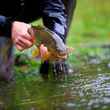
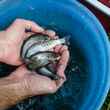
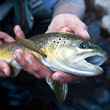













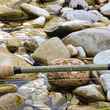
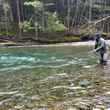
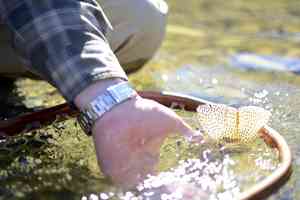
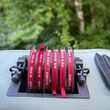


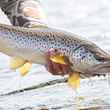

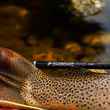
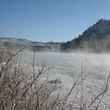
Comments
Brian Mack replied on Permalink
These strange or unpredictable feeding habits of Brown trout are often true for our Rainbow Trout on British Columbia's interior lakes. I have seen huge surface hatches with barely a fish showing and then suddenly the water is boiling with big 'Bows gulping sedges or midges. Upon changing up to match the hatch it's almost too late cause the trout go back down deep just like that! I guess that's why keeping 2 fly rods on the lake is key.
Rod Turton replied on Permalink
So true, i fished a very mediocre mayfly hatch a few days ago. I could barely keep the browns off the hook. The fish often hit the fly within seconds of it hitting the water. Other times i have seen spectacular hatches and have struggled to catch more than a few. The common theme though is I suspect if the fish notices the fly land in there window of vision they will be more inclined to rise to it. So try and cast close to a rise, if not don't leave your fly on the water for any longer than fifteen seconds
Bolderado replied on Permalink
Hi John, nice article! I agree with your thoughts in principle. When it comes to rising to a hatch the Cutts and brook trout are usually first on it, rainbows next and browns last, if at all. IMHO, when the food is plentiful subsurface, the big browns will sit in their feeding lane, usually a trough, and barely move, other than opening their mouth. When it comes to rising to a fly, they can be really fickle. However, the are always exceptions. I wade the flaming gorge of the Green a lot in the spring and during an epic BWO hatch, the browns which outnumber rainbows about 5:1 are consistently on those hatches as soon as they materialize. The same is true for the pseudo hatches in the fall. The yellow sally hatch in the summer is much less predictable, on the surface anyway, but they gorge themselves on nymphs and emergers. The key for me whe looking for dry fly action is knowing what, where and when, based upon year over year experience.
Mathew Supinski replied on Permalink
Excellent observations “ Mr.. Hatch Mag” ( sorry, don’t know who you are!)... if you are addicted to brown trout?, read this. You might find some good answers to your excellent observations...
#TheBrownTroutAtlanticSalmonNexus....Cheers!, MS
Jim Parks replied on Permalink
Perhaps you’re a victim of your own magazine (LOL). See the article related to tunnel vision. For many fly fishermen, too much emphasis is placed on what we want the trout to take and not what the trout wants. This article speaks only of “rising” browns. Instead of lamenting the why, watch the trout. If it’s lying on the bottom go DEEP. Often trout are not feeding on top, when the majority of food is subsurface. Streamers, heavy nymphs, are my go to choice. THEN, if I see a brown rise, I’ll go dry. Once while landing a nice, wild 21” brown in the Great Smoky Mountains National Park, I was joined by 3 guys from Georgia. They were astonished at the size of the trout. They stated they’d never caught anything close to the size of what I’d just released in the Smokies. I offered them a heavy #8 Guinea Fly. No takers. They said they didn’t use nymphs. My response, and you just saw the fly catch a trout like you’d never seen!
Jim Parks
Instagram: TailsOfTheSmokies
Anonymous replied on Permalink
Good article and written" dead on".
Any fly rodder who has spent any length of time at all fishing over Browns has come to innately know what you have enunciated so well.
Browns, any size, are the toughest of all salmonids to understand and coax to your fly.
Fishing over them is analogous to the game of golf. One day you hit nothing but great drives and putt well and the next day you are reduced to the role of "hacker". You never, ever know with brown trout even during great hatches. I have learned over 60 years to just come prepared and hope it's a good "golf" day.
Pages